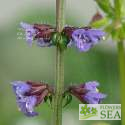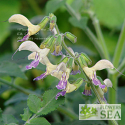(xin jiang shu wei cao) Long, branched spikes of blue-purple flowers with distinctive purple-red bracts makes this a showy garden plant. It is also well known as a medicinal sage in its Asian homelands.
Native to China’s Xinjiang province as well as the neighboring countries of Kazakhstan and Krygyzstan, this sage has a long history of use as an additive to the Chinese herbal remedy Danshen, which is often used to treat cardiovascular problems. Current medical research is focusing on the possibility that substances in the roots of this plant may aid in preventing eye and nerve damage caused by diabetes.
It is an adaptable plant that can handle many kinds of soil as long as they drain well. It grows in wastelands, sandy grasslands and along forest streams in its homelands, usually at elevations from about 1,000 to 6,000 feet. Its flowers bloom from May through July amid bright green foliage with oval to lance-shaped leaves. Give it full sun, partial shade or settings with morning sun and afternoon shade.
Also adaptable about irrigation, it needs regular watering and can handle heavy downpours. It acclimates well to persistently damp areas as long as drainage is good. Use this mid-height sage to edge a path or include it in a perennial border or woodland garden. Expect visits from honeybees and butterflies, which appreciate its nectar.










